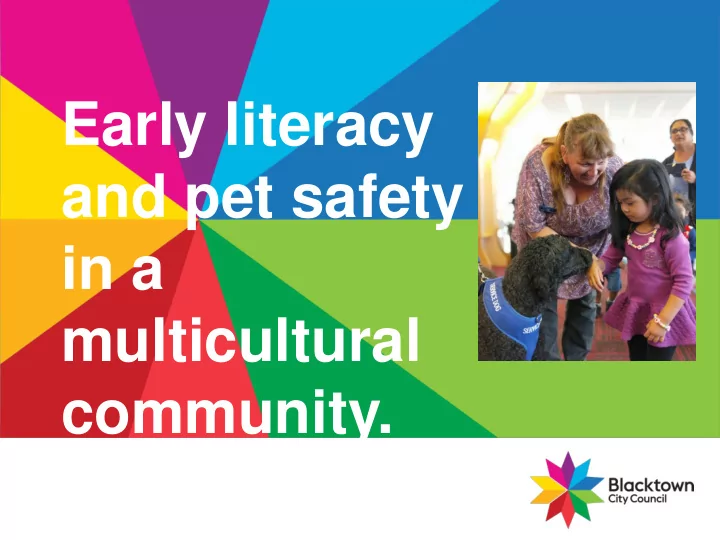

Early literacy and pet safety in a multicultural community.
What are we going to talk about? • Early literacy and pet safety in a multicultural community • You already know why pet safety and awareness is important • Our expertise – Early literacy and we in the library can be your partner to get the message out 2
Blacktown • Large population and growing: – Current population - 360,000 – Anticipated population by 2025 – 500,000 • Our population is young • Over half of our population are families with children 3
Multicultural Blacktown • We have people from 188 countries. – Top 5 countries of origin: – Philippines, India, New Zealand, Fiji and England • There are 182 languages spoken. – Top 5 languages spoken: • Tagalog, Hindi, Punjabi, Arabic and Filipino 4
Blacktown Animal Holding Facility Blacktown City Council acts as a holding facility or pound for other Councils in the Sydney region, these Councils being: • City of Canada Bay Council • Cumberland Council • Municipality of Hunters Hill • Lane Cove Council • Parramatta City Council • City of Ryde • Willoughby Council • Within Blacktown: – 117,313 companion animals, which includes 90,000 pet dogs of varying breeds 5
AHF Education programs aim to provide the community with the information that allows them to become responsible pet owners. • Distribution of educational literature through EDM and print material • Use of regular media promotions • Community contact with Council Rangers, • Free micro-chipping days, incorporating educational information • Annual Pet Festival • School Education programmes • Library Pet Storytime Program • The Pets on Line web page • Rehoming partnerships 6
Gap analysis • 2013 – Started going to schools; children 5 years + • Animal care and responsibility • Bite Prevention education • Since then – 80 primary schools and community groups visited – Over 200 sessions held – Presented to over 4,000 students and 500 teachers/adults • What about pre-schoolers? 7
How to reach the at-risk group? Carers and pre-school children who: • Do not attend pet events • Do not read articles in the local press • Do not have pets Multicultural audience who: • Have a different experience with dogs in their countries • Might not understand Australian laws We want to: • Build social cohesion – feeling safer in public areas • Build animal safety awareness 8
Finding a partner • Look to council sections; who was already successful reaching this target audience – 16 Baby Rhyme Time sessions – 10 storytime sessions – Each and every week – average of 47 attendees (ranging from 8-100 depending on the location) • Approached Blacktown City Libraries – Develop a Pet Storytime programme – To educate parents, grandparents, carers and children about how to interact safely with pets in public and home environments. 9
Why Blacktown City Libraries • 5 libraries; • Max Webber Library, Blacktown, • Our Library @ The Mount Druitt Hub, • Dennis Johnson Library, Stanhope Gardens, • Lalor Park Library and • Riverstone Library. • In 2017-18: • 1.3 million people walked through our doors • Over 1 million loans • Over 1,500 events with 67,000 people attending • Most popular events; Baby Rhyme Time and Storytime • Currently have collections in 29 languages. 10
Literacy programs using animals • Reading to dog programs – Individual child reads to non judgemental dog • Bring pets to work • Library pets • School holiday performances: Reptiles Alive / Featherdale Wildlife Wanderer, etc. 11
What is in the program? • Elements of the program: – singing – reading stories with audience participation – using props – live animal to deliver important information and – craft of Blackie to take home – AHF brochures supporting the important messages. • Each element is kept to a few minutes • We change the elements due to the attention span of very young children • By demonstrating with the live dog we are addressing the needs of non-English speaking carers. 12
Benefits for the library • Early Literacy Skills – Learn to use books (“Print Awareness”) – Learn new words (“Vocabulary”) – Hear sounds correctly (“Phonological Awareness”) – Appreciate storytelling (“Narrative Skills”) – Learn shapes and letters (“Letter Knowledge”) – Love books (“Print Motivation”) – Craft (Fine motor skills, creativity and imaginative development) 13
Setting up the program? • Risk management • Resources – Storybooks (samples) – Songs: changing the words • Training in storytime • Training in animal management • Scheduling, repeating and promotion 14
What is the program? • Showing the best bits 15
Evaluation • 19 sessions since October 2016 • Reaching an audience of 1,167 people. • Presented a session and workshop at Paint the Town REaD Early Literacy Conference at Katoomba in May 2017. • Visiting library students from University of Washington • Feedback & comments 16
Recommend
More recommend